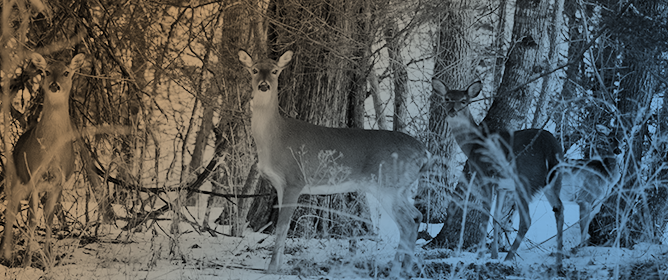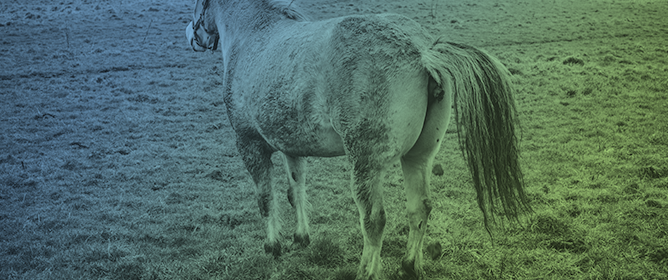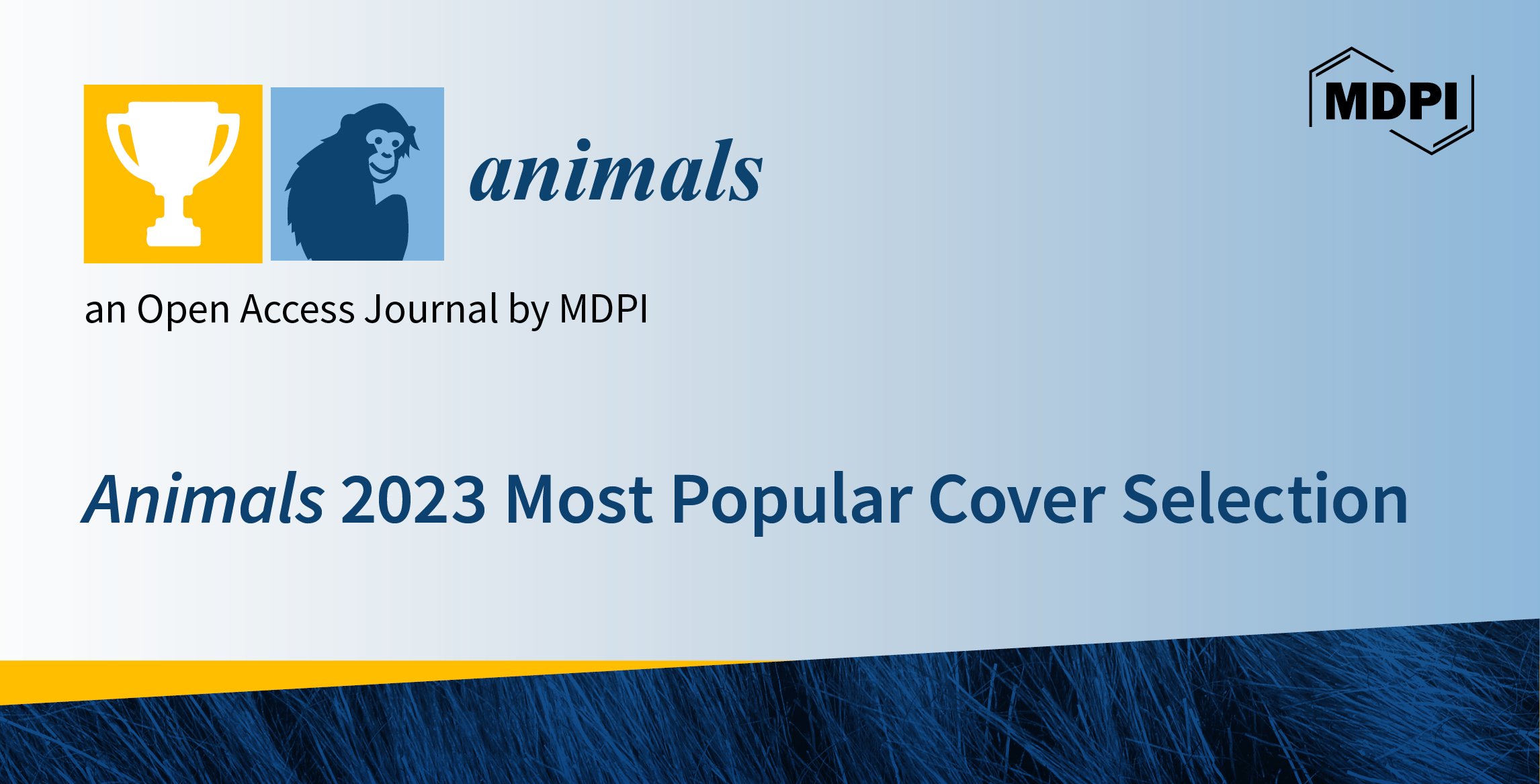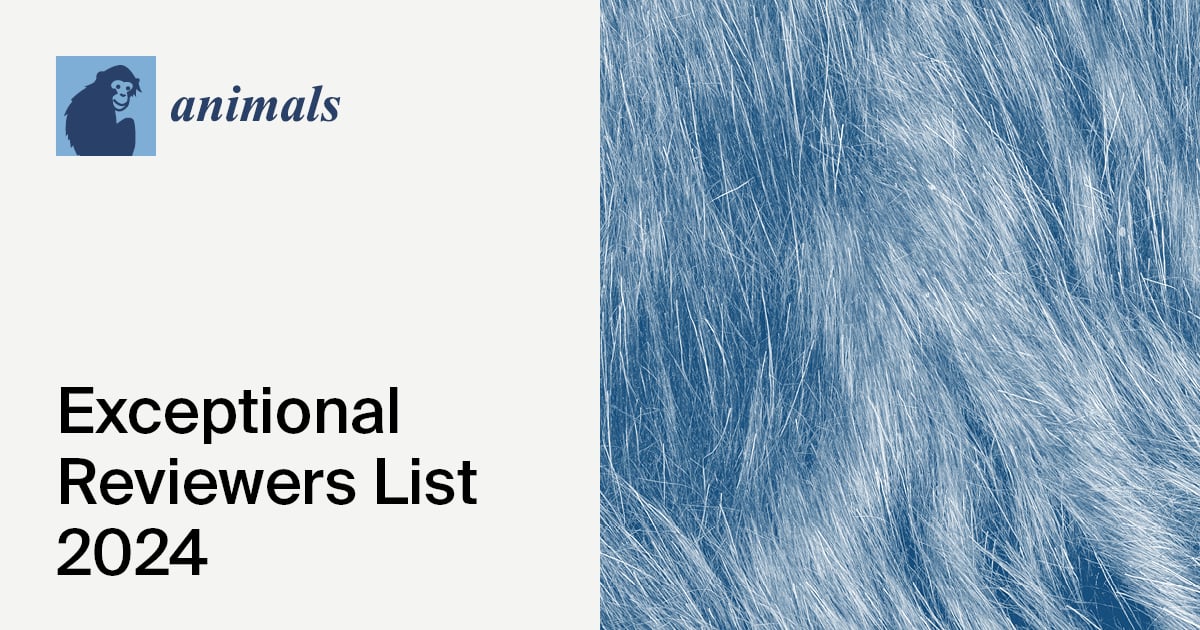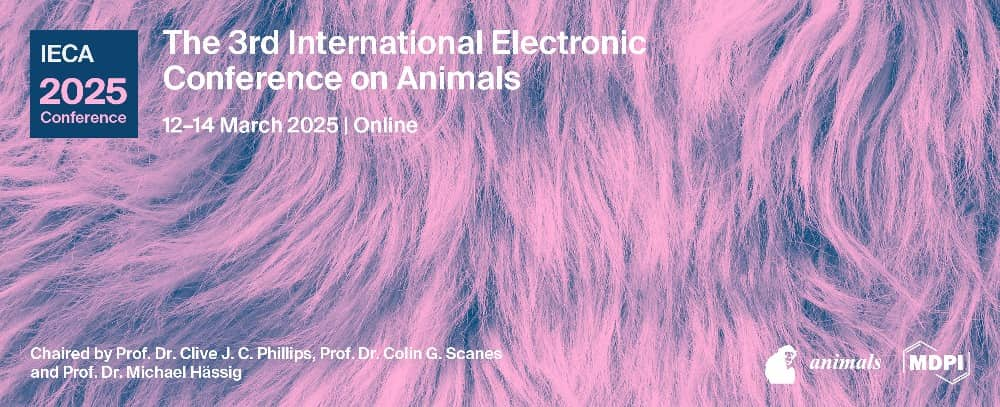Journal Description
Animals
Animals
is an international, peer-reviewed, open access journal devoted entirely to animals, including zoology and veterinary sciences, published semimonthly online by MDPI. The World Association of Zoos and Aquariums (WAZA), European College of Animal Welfare and Behavioural Medicine (ECAWBM), and Federation of European Laboratory Animal Science Associations (FELASA) are affiliated with Animals and their members receive a discount on the article processing charges.
- Open Access— free for readers, with article processing charges (APC) paid by authors or their institutions.
- High Visibility: indexed within Scopus, SCIE (Web of Science), PubMed, PMC, Embase, PubAg, AGRIS, Animal Science Database, CAB Abstracts, and other databases.
- Journal Rank: JCR - Q1 (Veterinary Sciences) / CiteScore - Q1 (General Veterinary)
- Rapid Publication: manuscripts are peer-reviewed and a first decision is provided to authors approximately 18.1 days after submission; acceptance to publication is undertaken in 2.5 days (median values for papers published in this journal in the second half of 2023).
- Recognition of Reviewers: reviewers who provide timely, thorough peer-review reports receive vouchers entitling them to a discount on the APC of their next publication in any MDPI journal, in appreciation of the work done.
- Companion journals for Animals include: Birds, Ruminants and Zoonotic Diseases.
Impact Factor:
3.0 (2022);
5-Year Impact Factor:
3.2 (2022)
Latest Articles
Ten Years of Mediterranean Monk Seal Stranding Records in Greece under the Microscope: What Do the Data Suggest?
Animals 2024, 14(9), 1309; https://doi.org/10.3390/ani14091309 (registering DOI) - 26 Apr 2024
Abstract
This paper presents the results of an analysis of stranding events of the Mediterranean monk seal Monachus monachus over a decade. The analysis involved categorization according to the cause of stranding and seasonality, the identification of hotspot stranding areas and an assessment of
[...] Read more.
This paper presents the results of an analysis of stranding events of the Mediterranean monk seal Monachus monachus over a decade. The analysis involved categorization according to the cause of stranding and seasonality, the identification of hotspot stranding areas and an assessment of possible correlations between stranding events and environmental/climatic patterns using time series analysis. Moreover, Generalized Additive Models (GAMs) were applied to explore the effects of the size of small-scale fishing grounds, the number of species sightings, and the occurrence of reproduction sites on “human-related” strandings. Finally, special focus was put on the central part of the eastern Ionian Sea for the assessment of stranding hotspot areas by means of the Multi-Criteria Decision Analysis (MCDA) approach, based on different kinds of spatial information such as anthropogenic pressures and the location of breeding sites and feeding grounds. Time series analysis results revealed that oscillation indices, during the first half of the year, and sea surface temperature (SST) in the Mediterranean from October to December were positively correlated with monk seal stranding events. GAMs underlined that areas combining extended small-scale fishery grounds and a higher number of sightings were more likely to cause more strandings. Regarding spatial analyses, the central Aegean Sea was highlighted as a hotspot for “human-related strandings”, while the MCDA approach emphasized that the southern coasts of Cephalonia and the gulf between Lefkada and mainland Greece were susceptible to subadult strandings.
Full article
(This article belongs to the Special Issue The Mediterranean Monk Seal and Other Endangered Marine Mammals. From Past to Future: Perspectives on Ecology, Biology, Monitoring, and Conservation)
Open AccessArticle
Effects of the Marek’s Disease Vaccine on the Performance, Meat Yield, and Incidence of Woody Breast Myopathy in Ross 708 Broilers When Administered Alone or in Conjunction with In ovo and Dietary Supplemental 25-Hydroxycholecalciferol
by
Seyed Abolghasem Fatemi, Ayoub Mousstaaid, Christopher J. Williams, Joshua Deines, Sabin Poudel, Ishab Poudel, Elianna Rice Walters, April Waguespack Levy and Edgar David Peebles
Animals 2024, 14(9), 1308; https://doi.org/10.3390/ani14091308 - 26 Apr 2024
Abstract
The effects of the Marek’s disease vaccine (MDV) on the live performance, breast meat yield, and incidence of woody breast myopathy (WBM) of Ross 708 broilers were investigated when administered alone or in conjunction with in ovo and dietary supplemental 25-hydroxycholecalciferol (25OHD3
[...] Read more.
The effects of the Marek’s disease vaccine (MDV) on the live performance, breast meat yield, and incidence of woody breast myopathy (WBM) of Ross 708 broilers were investigated when administered alone or in conjunction with in ovo and dietary supplemental 25-hydroxycholecalciferol (25OHD3). At 18 d of incubation (doi), four in ovo injection treatments were randomly assigned to live embryonated Ross 708 broiler hatching eggs: (1) non-injected; (2) commercial MDV alone; or MDV containing either (3) 1.2 or (4) 2.4 μg of 25OHD3. An Inovoject multi-egg injector was used to inject a 50 μL solution volume into each egg. The birds were provided a commercial diet that contained 250 IU of cholecalciferol/kg of feed (control) or a commercial diet that was supplemented with an additional 2760 IU of 25OHD3/kg of feed (HyD-diet). In the growout period, 14 male broilers were placed in each of 48 floor pens resulting 6 replicated pens per in ovo x dietary treatment combination. Live performance variable were measured at each dietary phases from 0 to 14, 15 to 28, and 29 to 40 d of age (doa). At 14 and 40 doa, pectoralis major (P. major) and pectoralis minor (P. minor) muscles were determined for one bird within each of the six replicate pens. At 41 doa, WBM incidence was determined. No significant main or interaction effects occurred for WBM among the dietary or in ovo injection treatments. However, in response to in ovo 25OHD3 supplementation, BW and BWG in the 29 to 40 doa period and BWG and FCR in the 0 to 40 doa period improved. In addition, at 40 and 41 doa, breast meat yield increased in response to in ovo and dietary 25OHD3 supplementation. Future research is needed to determine the possible reasons that may have been involved in the aforementioned improvements.
Full article
(This article belongs to the Collection Current Advances in Poultry Research)
Open AccessCase Report
Ovarian Fibrothecoma in a Mare—Case Report
by
Raimonda Tamulionytė-Skėrė, Nomeda Juodžiukynienė, Renata Gruodytė, Paulina Rimkutė, Iveta Duliebaitė and Akvilė Savickytė
Animals 2024, 14(9), 1307; https://doi.org/10.3390/ani14091307 - 26 Apr 2024
Abstract
Ovarian tumors in mares are uncommon in comparison to other neoplasms and are classified into three categories: gonadal stromal tumors, coelomic epithelium surface tumors, and germinal cell tumors. Some ovarian neoplasms histologically show a mixture of multiple cell types in the same tumor,
[...] Read more.
Ovarian tumors in mares are uncommon in comparison to other neoplasms and are classified into three categories: gonadal stromal tumors, coelomic epithelium surface tumors, and germinal cell tumors. Some ovarian neoplasms histologically show a mixture of multiple cell types in the same tumor, such as fibrothecoma; therefore, the differentiation between fibroma and thecoma is often difficult. According to the World Health Organization, fibrothecomas are classified as sex-cord stromal tumors (pure stromal tumors). Neoplasms such as fibrothecoma present with limited morphological, clinical, ultrasonographic, and endocrine profile characteristics. To diagnose this type of tumor, a broad clinical examination is needed, but histopathology remains the most accurate. Herein, we report a case of incidentally found ovarian fibrothecoma during a diagnostic laparotomy in a 6-year-old Dutch Warmblood (KWPN) mare who presented to the clinic with colic symptoms. After a unilateral ovariectomy, the altered right ovary was diagnosed as fibrothecoma based on histopathological features.
Full article
(This article belongs to the Section Animal Reproduction)
Open AccessArticle
Validation of Bos taurus SNPs for Milk Productivity of Sahiwal Breed (Bos indicus), Pakistan
by
Asma Younis, Imtiaz Hussain, Syeda Nadia Ahmad, Amin Shah, Iram Inayat, Muhammad Ali Kanwal, Sadia Suleman, Muhammad Atif Kamran, Saima Matloob and Khawaja Raees Ahmad
Animals 2024, 14(9), 1306; https://doi.org/10.3390/ani14091306 - 26 Apr 2024
Abstract
The aim of the present study was the validation of the already reported Bos taurus SNPs in the Sahiwal breed. A total of nine SNPs of the casein gene were studied. Out of nine, seven Bos taurus SNPs of casein protein genes were
[...] Read more.
The aim of the present study was the validation of the already reported Bos taurus SNPs in the Sahiwal breed. A total of nine SNPs of the casein gene were studied. Out of nine, seven Bos taurus SNPs of casein protein genes were found to be significantly associated with milk productivity traits. The genomic DNA was extracted from the mammary alveolar endothelial cells of a flock of 80 purebred Sahiwal lactating dams available at Khizrabad Farm near Sargodha. New allele-specific primers were designed from the NCBI annotated sequence database of Bos taurus to obtain 100 nt-long PCR products. Each dam was tested separately for all the SNPs investigated. Animals with genotype GG for the SNPs rs43703010, rs10500451, and 110323127, respectively, exhibited high milk yield. Similarly, animals with genotype AA for the SNPs rs11079521, rs43703016, and rs43703017 showed high milk yield consistently. For the SNP rs43703015, animals with genotype CC showed high milk productivity. These above-mentioned SNPs have previously been reported to significantly up-regulate casein protein contents in Bos taurus. Our results indicated SNPs that significantly affect the milk protein contents may also significantly increase per capita milk yield. These finding suggest that the above-mentioned reported SNPs can also be used as genetic markers of milk productivity in Sahiwal cattle.
Full article
(This article belongs to the Section Cattle)
►▼
Show Figures

Figure 1
Open AccessArticle
A Pilot Study of the Role of Selected Biomarkers of Kidney Injury in Dogs with Dilated Cardiomyopathy
by
Karolina Wrześniewska, Jacek Madany, Dawid Tobolski, Beata Żylińska, Andrzej Milczak and Aleksandra Sobczyńska-Rak
Animals 2024, 14(9), 1305; https://doi.org/10.3390/ani14091305 - 26 Apr 2024
Abstract
Heart and kidney diseases are among the most frequent medical conditions diagnosed in small animals. Due to the functional interconnection between these organs, the concept of the cardio–renal axis has been developed. In this context, renal disease or dysfunction often occurs secondary to
[...] Read more.
Heart and kidney diseases are among the most frequent medical conditions diagnosed in small animals. Due to the functional interconnection between these organs, the concept of the cardio–renal axis has been developed. In this context, renal disease or dysfunction often occurs secondary to heart diseases, such as dilated cardiomyopathy (DCM). DCM is the most common cardiomyopathy and a leading cause of mortality in large-breed dogs. Traditional biomarkers like creatinine or symmetric dimethylarginine concentration are not always effective, especially in the early stages of the disease, underscoring the need for more sensitive markers of renal impairment during heart failure (HF). This study aimed to evaluate the efficacy of selected biomarkers as indicators for early kidney damage in dogs with stage B2 DCM. We measured serum concentrations of cystatin C, KIM-1 (kidney injury molecule-1), and NGAL (neutrophil gelatinase-associated lipocalin) and their ratios to creatinine, analyzing their diagnostic values. Cystatin C was quantified using a sandwich enzyme immunoassay, while KIM-1 and NGAL were measured with enzyme-linked immunosorbent assay kits designed for canine diagnostics. The concentrations were indexed against serum creatinine. The study included 26 dogs: 9 with HF and 17 healthy controls. The mean ± standard deviation for healthy dogs for cystatin C, cystatin C/creatinine ratio, KIM-1, KIM-1/creatinine ratio, NGAL, and NGAL/creatinine ratio were 0.24 ± 0.04, 0.26 ± 0.07, 0.61 ± 0.07, 0.67 ± 0.13, 2.76 ± 1.8, and 2.79 ± 1.81, respectively. For DCM dogs, these values were 0.27 ± 0.1, 0.32 ± 0.12, 0.61 ± 0.08, 0.69 ± 0.17, 6.46 ± 5.22 (p = 0.02), and 7.99 ± 6.53 (p = 0.04). This study’s findings suggest that during the asymptomatic phase of DCM, only NGAL concentration and the NGAL/creatinine ratio may serve as diagnostic markers for early-stage kidney injury.
Full article
(This article belongs to the Special Issue Advances in Companion Animal Clinical Pathology)
►▼
Show Figures
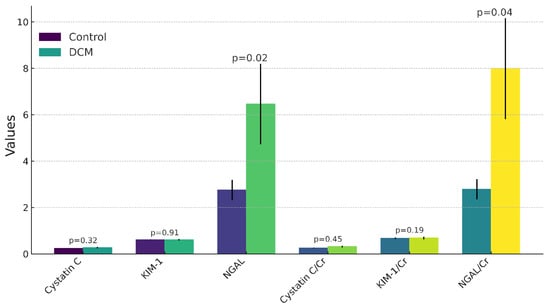
Figure 1
Open AccessArticle
A Retrospective Descriptive Study of Staphylococcus Species Isolated from Canine Specimens Submitted to a Diagnostic Laboratory in South Africa, 2012–2017
by
Themba Sigudu, Daniel Qekwana and James Oguttu
Animals 2024, 14(9), 1304; https://doi.org/10.3390/ani14091304 - 26 Apr 2024
Abstract
There is a scarcity of published studies on the occurrence of Staphylococcus spp. Among dogs in South Africa. The objective of the study was to characterise the Staphylococcus spp. Isolated from dog samples submitted to a veterinary diagnostic laboratory in South Africa in
[...] Read more.
There is a scarcity of published studies on the occurrence of Staphylococcus spp. Among dogs in South Africa. The objective of the study was to characterise the Staphylococcus spp. Isolated from dog samples submitted to a veterinary diagnostic laboratory in South Africa in terms of time, place, and person. This study utilised a dataset of 1627 positive Staphylococcus isolates obtained from a veterinary diagnostic laboratory in South Africa from 2012 to 2017. Out of the 1627 confirmed isolates, 10 different species of Staphylococcus were identified. Among these, 92.0% were classified as coagulase-positive staphylococci (CoPS), 6.0% were coagulase-negative staphylococci (CoNS), and 3.0% were coagulase-variable. Male dogs contributed just over half (53.2%) of the Staphylococcus isolates, while female dogs contributed the remaining 46.8%. The largest proportion of isolates (23.2%) were obtained from dogs aged ≥ 9 years, with the highest number of isolates originating from KwaZulu-Natal Province (45.0%) and the least from Northern Cape Province (0.1%). Out of the total samples included in the records, the majority (46.0%) were skin specimens. The number of Staphylococcus isolates recorded showed limited variation between the seasons (24.3% in autumn, 26.3% in winter, 26.0% in spring, and 24.0% in summer). This study highlighted the diversity of Staphylococcus spp. isolated from dogs, and the burden of staphylococcal carriage among dogs in South Africa. Further research is required to examine the factors that contribute to the observed discrepancies in the proportions of Staphylococcus spp. between the provinces.
Full article
(This article belongs to the Section Companion Animals)
►▼
Show Figures
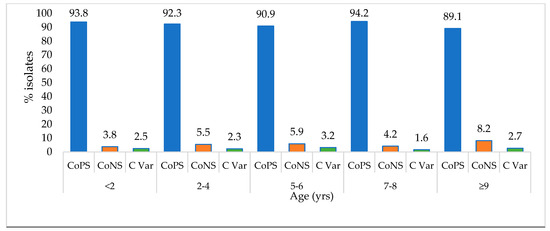
Figure 1
Open AccessArticle
Effects of Zilpaterol Hydrochloride with a Combination of Vitamin D3 on Feedlot Lambs: Growth Performance, Dietary Energetics, Carcass Traits, and Meat Quality
by
Karla H. Leyva-Medina, Horacio Dávila-Ramos, Jesús J. Portillo-Loera, Omar S. Acuña-Meléndez, Adriana Cervantes-Noriega, Jaime N. Sánchez-Pérez, Gamaliel Molina-Gámez, Javier G. Rodríguez-Carpena, Mario A. Mejía-Delgadillo and Juan C. Robles-Estrada
Animals 2024, 14(9), 1303; https://doi.org/10.3390/ani14091303 - 26 Apr 2024
Abstract
This study evaluated the impact of supplementing ZH in combination with D3 on the growth performance, energy efficiency, carcass traits, and meat quality of feedlot lambs. Thirty-two Dorper × Katahdin cross lambs (37.3 ± 5.72 kg) were utilized in a 29 d experiment
[...] Read more.
This study evaluated the impact of supplementing ZH in combination with D3 on the growth performance, energy efficiency, carcass traits, and meat quality of feedlot lambs. Thirty-two Dorper × Katahdin cross lambs (37.3 ± 5.72 kg) were utilized in a 29 d experiment in a completely randomized block design with a 2 × 2 factorial structure consisting of two levels of ZH for 26 d (0 and 0.20 mg/kg PV−1) and two levels of D3 for 7 d (0 and 1.5 × 106 IU/d−1). ZH improved (p ≤ 0.05) the average daily gain (ADG) and feed efficiency by 9.9% and 17.8%, respectively, as well as hot carcass weight (HCW) and dressing carcass by 4.3% and 2.6%, respectively. (p ≤ 0.03). However, ZH increased (p < 0.01) muscle pH and Warner–Bratzler shear force (WBSF) (2.5 and 23.0%, respectively). D3 supplementation negatively affected (p ≤ 0.02) dry matter intake (DMI) (last 7 d) and ADG by 15.7% and 18.1%. On the other hand, D3 improved the pH of the longissimus thoracis muscle by 1.7% (p = 0.03) without affecting WBSF. When D3 was supplemented in combination with ZH, it was observed that meat quality was improved by reducing muscle pH compared to lambs treated only with ZH. However, D3 did not improve the meat tenderness negatively affected by ZH supplementation.
Full article
(This article belongs to the Special Issue Recent Advances in Nutrition, Management and Health of Feedlot Cattle and Lambs)
►▼
Show Figures
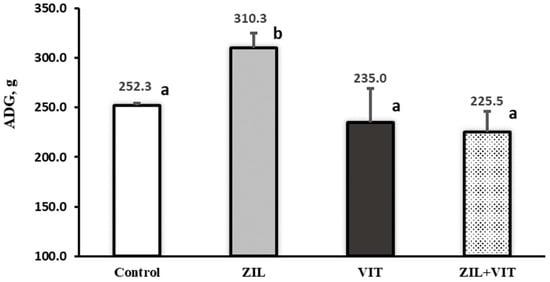
Figure 1
Open AccessCase Report
Hepatic Epithelioid Hemangioendothelioma in a Dog
by
Luisa Vera Muscatello, Federico Massari, Paola Roccabianca, Giuseppe Sarli, Cinzia Benazzi and Marco Luigi Bianchi
Animals 2024, 14(9), 1302; https://doi.org/10.3390/ani14091302 - 25 Apr 2024
Abstract
A 5-year-old spayed female Breton dog was referred for a thyroid nodule. A total body CT scan evidenced multifocal hepatic nodules. Cytological liver samples were hemodiluted and non-diagnostic. Following a thyroidectomy, the histology was consistent with a follicular-compact thyroid carcinoma. On laparoscopy, most
[...] Read more.
A 5-year-old spayed female Breton dog was referred for a thyroid nodule. A total body CT scan evidenced multifocal hepatic nodules. Cytological liver samples were hemodiluted and non-diagnostic. Following a thyroidectomy, the histology was consistent with a follicular-compact thyroid carcinoma. On laparoscopy, most hepatic lobes had multifocal dark-red nodules that were biopsied for histology. Microscopically, the hepatic parenchyma in the nodules was substituted by blood channels lined by bland spindle cells but adjacent to epithelioid neoplastic cells, single or in clusters, embedded in a moderate amount of edematous collagen matrix. These cells had optically empty cytoplasmic space, occasionally containing erythrocytes (microlumina). Spindle and epithelioid cells expressed membranous-to-cytoplasmic CD31 and FVIII-RA consistent with endothelial origin. Based on morphology and immunolabelling, a hemangioendothelioma with epithelioid differentiation was diagnosed. Lesions in the liver were initially stable, showing progression with time. The dog was alive with no systemic clinical signs 36 months after laparoscopy.
Full article
(This article belongs to the Section Veterinary Clinical Studies)
Open AccessArticle
Antimicrobial Resistance and Biofilm Formation of Bordetella bronchiseptica in Central China, with Evidence of a Rare Heteroresistance Strain to Gentamicin
by
Li Yi, Haoran Fan, Shuo Yuan, Rishun Li, Haikun Wang, Yingying Quan, Hui Zhang, Yuxin Wang and Yang Wang
Animals 2024, 14(9), 1301; https://doi.org/10.3390/ani14091301 - 25 Apr 2024
Abstract
Bordetella bronchiseptica is a significant contributor to respiratory disease in pigs, leading to substantial economic losses in the swine industry worldwide. We isolated 52 B. bronchiseptica strains from 542 samples collected from pigs with atrophic rhinitis and bronchopneumonia in central China. Multi-locus sequence
[...] Read more.
Bordetella bronchiseptica is a significant contributor to respiratory disease in pigs, leading to substantial economic losses in the swine industry worldwide. We isolated 52 B. bronchiseptica strains from 542 samples collected from pigs with atrophic rhinitis and bronchopneumonia in central China. Multi-locus sequence typing identified two prevalent sequence types: ST6 (69.23%) and ST7 (30.77%). PCR-based detection of seven virulence genes (fhaB, prn, cyaA, dnt, bteA, fla, and bfrZ) revealed that six of these genes were present in over 90% of the isolates, with bfrZ being the exception at 59.62%. Antimicrobial susceptibility testing, performed using the K-B method, demonstrated high sensitivity to enrofloxacin, polymyxin, and doxycycline but a notable resistance to tylosin, trimethoprim, tobramycin, ciprofloxacin, and amikacin. Remarkably, 86.54% of the isolates exhibited a multidrug-resistant phenotype. Notably, we successfully screened a strain of B. bronchiseptica with a heteroresistance phenotype to gentamicin using population analysis profiling, which is a rare case. Biofilm-formation assays indicated that 96.15% of the isolates possessed biofilm-forming capabilities. These findings provide crucial insights into the prevalence of B. bronchiseptica in central China, facilitating the development of effective preventive measures to safeguard both animal and human health.
Full article
(This article belongs to the Special Issue Bacteria Disease Research in Livestock and Poultry: Epidemiology, Pathogenicity, Drug Resistance and Control)
Open AccessFeature PaperArticle
Current State of Canine Heartworm in Portugal
by
Joana Esteves-Guimarães, Jorge Isidoro Matos, Beatriz Leal-Sousa, Pedro Oliveira, Luís Lobo, Ana Cristina Silvestre-Ferreira, Carla S. Soares, Iván Rodríguez-Escolar, Elena Carretón, Rodrigo Morchón, Ana Patrícia Fontes-Sousa and José Alberto Montoya-Alonso
Animals 2024, 14(9), 1300; https://doi.org/10.3390/ani14091300 - 25 Apr 2024
Abstract
The favourable geo-climatic conditions in Portugal have made it highly conducive to the development of Dirofilaria immitis in dogs, leading to its identification as an endemic region. This nematode is rapidly spreading across Europe, particularly in northeastern countries. The objective of this study
[...] Read more.
The favourable geo-climatic conditions in Portugal have made it highly conducive to the development of Dirofilaria immitis in dogs, leading to its identification as an endemic region. This nematode is rapidly spreading across Europe, particularly in northeastern countries. The objective of this study was to provide an updated assessment of the prevalence of this disease in Portuguese dogs, analysing the results in relation to epidemiological and geo-environmental factors, and to identify potential risk factors. A total of 1367 dogs from all continental and insular districts were included in the study and tested for D. immitis antigens. The overall prevalence was found to be 5.9%. It was observed that the disease is spreading northward, with previously unaffected districts now reporting cases, and that the prevalence in coastal districts exceeded that of inland ones. Notably, the Aveiro district exhibited a significant increase in D. immitis prevalence, while in certain districts such as Setúbal, Santarém, Madeira, or Faro, a stabilisation or decrease in prevalence was noted. Furthermore, outdoor and older dogs were found to be at a higher risk of infection. No positive cases were detected in the Azores. Most of the infected dogs were located in areas of high and medium risk of infection. This study underscores the importance of implementing pharmacological prophylaxis, vector control strategies, and public awareness programs to control the spread of this zoonotic disease.
Full article
(This article belongs to the Topic Zoonotic Vector-Borne Diseases of Companion Animals)
►▼
Show Figures
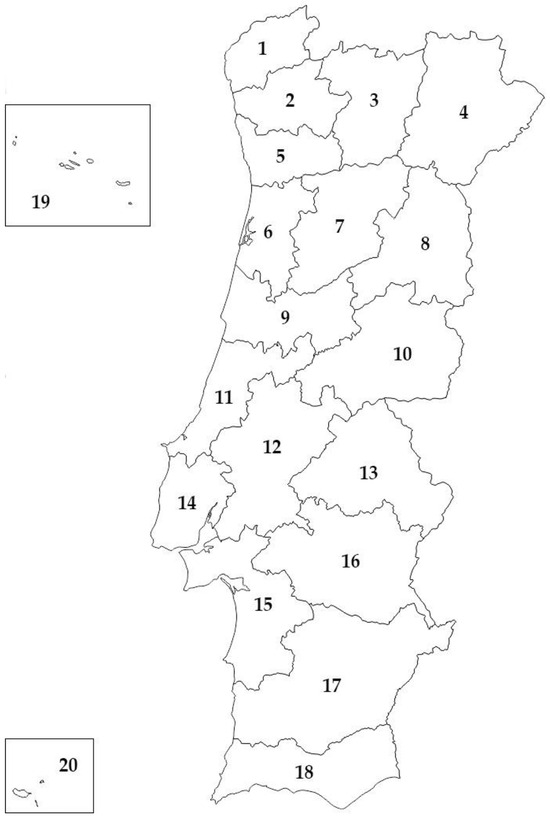
Figure 1
Open AccessArticle
Effects of Dietary Supplementation of Bile Acids on Growth, Glucose Metabolism, and Intestinal Health of Spotted Seabass (Lateolabrax maculatus)
by
Yongping Liu, Xiao Li, Jibin Lin, Kai Song, Xueshan Li, Ling Wang, Chunxiao Zhang and Kangle Lu
Animals 2024, 14(9), 1299; https://doi.org/10.3390/ani14091299 - 25 Apr 2024
Abstract
An 8-week feeding trial was performed to investigate the effects of dietary bile acids on growth, glucose metabolism, and intestinal health in spotted seabass (Lateolabrax maculatus) reared at high temperatures (33 °C). The fish (20.09 ± 1.12 g) were fed diets
[...] Read more.
An 8-week feeding trial was performed to investigate the effects of dietary bile acids on growth, glucose metabolism, and intestinal health in spotted seabass (Lateolabrax maculatus) reared at high temperatures (33 °C). The fish (20.09 ± 1.12 g) were fed diets supplemented with bile acids: 0 (Con), 400 (BA400), 800 (BA800), and 1200 (BA1200) mg/kg, respectively. The results showed that the growth was promoted in fish at the BA800 treatment compared with the control (p < 0.05). Increased enzyme activities and transcripts of gluconeogenesis in the liver were observed, whereas decreased enzyme activities and transcripts of glycolysis, as well as glycogen content, were shown in the BA800 treatment (p < 0.05). The transcripts of bile acid receptors fxr in the liver were up-regulated in the BA800 treatment (p < 0.05). A bile acid supplementation of 800 mg/kg improved the morphological structure in the intestine. Meanwhile, intestinal antioxidant physiology and activities of lipase and trypsin were enhanced in the BA800 treatment. The transcripts of genes and immunofluorescence intensity related to pro-inflammation cytokines (il-1β, il-8, and tnf-α) were inhibited, while those of genes related to anti-inflammation (il-10 and tgf-β) were induced in the BA800 treatment. Furthermore, transcripts of genes related to the NF-κB pathway in the intestine (nfκb, ikkα, ikkꞵ, and ikbα1) were down-regulated in the BA800 treatment. This study demonstrates that a dietary bile acid supplementation of 800 mg/kg could promote growth, improve glucose metabolism in the liver, and enhance intestinal health by increasing digestive enzyme activity and antioxidant capacity and inhibiting inflammatory response in L. maculatus.
Full article
(This article belongs to the Special Issue Novel Insights into Lipid Metabolism in Aquatic Animals)
Open AccessArticle
Alginate Oligosaccharide Alleviates Lipopolysaccharide-Induced Apoptosis and Inflammatory Response of Rumen Epithelial Cells through NF-κB Signaling Pathway
by
Xiaoyuan Qiu, Fuquan Yin, Chunmei Du, Jian Ma and Shangquan Gan
Animals 2024, 14(9), 1298; https://doi.org/10.3390/ani14091298 - 25 Apr 2024
Abstract
AOS alleviates inflammatory responses; however, whether it exerts an effect on the rumen or regulates rumen inflammatory reaction remains unknown. In this study, firstly, the ovine ruminal epithelial cells (ORECs) were treated with 0, 200, 400, 600, and 800 µg/mL AOS, hoping to
[...] Read more.
AOS alleviates inflammatory responses; however, whether it exerts an effect on the rumen or regulates rumen inflammatory reaction remains unknown. In this study, firstly, the ovine ruminal epithelial cells (ORECs) were treated with 0, 200, 400, 600, and 800 µg/mL AOS, hoping to explore whether AOS hurt cell health. The results showed that compared with the AOS-0 group, the AOS-400 group could significantly increase (p < 0.05) cell viability, reduce (p < 0.05) reactive oxygen species (ROS) and interleukin (IL)-6 content, and have no adverse effect on cells. Secondly, we used LPS to construct an in vitro inflammatory model of rumen epithelial cells and then explored the protective role of AOS on rumen epithelial cells. The study was divided into three groups: the control group (CON), LPS, and LPS + AOS. The results demonstrated that the LPS + AOS group significantly increased the cell viability and reduced the ROS level in comparison with the LPS group (p < 0.05). Pretreatment with AOS also repressed (p < 0.05) the secretion of IL-1β, IL-6, IL-8, and immunoglobulin (Ig)A from ORECs in the culture medium following LPS. In terms of tight junction (TJ) proteins, AOS treatment also significantly increased (p < 0.05) the zonula occludens 1 (ZO-1) and Occludin expression. The apoptosis rate, Caspase3, Caspase9, BAD, and BCL-2/BAX were decreased (p < 0.05) after AOS treatment, and the expression of BCL-2 was increased (p < 0.05). In addition, the expressions of Toll-like receptor 4 (TLR4), myeloid differentiation factor 88 (MyD88), and nuclear factor-κB (NF-κB) were inhibited (p < 0.05) with the addition of AOS. At the protein level, pretreatment of AOS decreased (p < 0.05) the expression of MyD88 and the phosphorylation level of inhibitor κB α (IκBα) after the LPS challenge. Taken together, our results indicated that AOS could alleviate the LPS-induced apoptosis and inflammatory response of rumen epithelial cells through the NF-κB signaling pathway, which may be a promising strategy for treating apoptosis and inflammation in sheep breeding.
Full article
(This article belongs to the Section Animal Nutrition)
Open AccessArticle
Dissecting the Effects of Cephenemyia stimulator on the Olfactory Turbinates and Nasopharynx of Roe Deers (Capreolus capreolus)
by
Irene Ortiz-Leal, Mateo V. Torres, Ana López-Beceiro, Pablo Sanchez-Quinteiro and Luis Fidalgo
Animals 2024, 14(9), 1297; https://doi.org/10.3390/ani14091297 - 25 Apr 2024
Abstract
Nasopharyngeal myiasis in European roe deer (Capreolus capreolus) is a pathological condition caused by the larval stages of Cephenemyia stimulator, a fly from the Oestridae family. These larvae reside in the host’s upper respiratory tract for months, inducing significant tissue damage and
[...] Read more.
Nasopharyngeal myiasis in European roe deer (Capreolus capreolus) is a pathological condition caused by the larval stages of Cephenemyia stimulator, a fly from the Oestridae family. These larvae reside in the host’s upper respiratory tract for months, inducing significant tissue damage and clinical symptoms. The lifecycle of Cephenemyia stimulator is complex, involving three larval stages before maturation into adult flies, with each stage contributing to the progressive pathology observed in the host. Despite their prevalence, the histopathological effects of these larvae in the nasal and nasopharyngeal cavities have been understudied. Our study fills this knowledge gap by providing a detailed histopathological analysis of the affected tissues, using various staining techniques to reveal the extent and nature of the damage caused by these parasitic larvae. This histopathological examination reveals significant alterations within the nasopharyngeal mucosa and nasal cavity, including erythematous changes, mucosal metaplasia, fibrosis, and tissue necrosis. Parasitic cysts and eosinophilic infiltration further characterize the impact of the infestation, compromising not only the mucosal integrity but also potentially the olfactory function of the affected animals. This research is crucial for understanding the impact of myiasis on both the health and olfactory capabilities of roe deer populations and could have significant implications for wildlife management and conservation.
Full article
(This article belongs to the Special Issue Chemical Senses in Vertebrates)
Open AccessArticle
Effects of Environmental Enrichment on Exposure to Human-Relevant Mixtures of Endocrine Disrupting Chemicals in Zebrafish
by
Lina Birgersson, Sanne Odenlund and Joachim Sturve
Animals 2024, 14(9), 1296; https://doi.org/10.3390/ani14091296 - 25 Apr 2024
Abstract
Fish models used for chemical exposure in toxicological studies are normally kept in barren tanks without any structural environmental enrichment. Here, we tested the combined effects of environmental enrichment and exposure to two mixtures of endocrine disrupting chemicals (EDCs) in zebrafish. Firstly, we
[...] Read more.
Fish models used for chemical exposure in toxicological studies are normally kept in barren tanks without any structural environmental enrichment. Here, we tested the combined effects of environmental enrichment and exposure to two mixtures of endocrine disrupting chemicals (EDCs) in zebrafish. Firstly, we assessed whether developmental exposure to an EDC mixture (MIX G1) combined with rearing the fish in an enriched environment influenced behaviour later in life. This was evaluated using locomotion tracking one month after exposure, showing a significant interaction effect between enrichment and the MIX G1 exposure on the measured locomotion parameters. After three months, we assessed behaviour using custom-made behaviour tanks, and found that enrichment influenced swimming activity. Control fish from the enriched environment were more active than control fish from the barren environment. Secondly, we exposed adult zebrafish to a separate EDC mixture (MIX G0) after rearing them in a barren or enriched environment. Behaviour and hepatic mRNA expression for thyroid-related genes were assessed. There was a significant interaction effect between exposure and enrichment on swimming activity and an effect of environment on latency to approach the group of conspecifics, where enriched fish took more time to approach the group, possibly indicating that they were less anxious. Hepatic gene expression of a thyroid-related gene (thrb) was significantly affected by EDC exposure, while enrichment had no discernible impact on the expression of the measured genes. In conclusion, environmental enrichment is important to consider when studying the effects of EDCs in fish.
Full article
(This article belongs to the Special Issue Recent Progress in Zebrafish Research)
Open AccessArticle
Strategic Challenges to the Eradication of African Swine Fever Genotype II in Domestic Pigs in North Italy
by
Silvia Pavone, Silvia Bellini, Carmen Iscaro, Marco Farioli, Mario Chiari, Antonio Lavazza, Luigi Ruocco, Davide Lelli, Giorgia Pintus, Paola Prati and Francesco Feliziani
Animals 2024, 14(9), 1295; https://doi.org/10.3390/ani14091295 - 25 Apr 2024
Abstract
African swine fever (ASF) is a severe viral disease characterized by high lethality in suids and caused by the African Swine Fever Virus (ASFV). The ASF genotype I virus was introduced to Europe in 1957, marking the onset of the first European epidemic
[...] Read more.
African swine fever (ASF) is a severe viral disease characterized by high lethality in suids and caused by the African Swine Fever Virus (ASFV). The ASF genotype I virus was introduced to Europe in 1957, marking the onset of the first European epidemic wave. In 2007, ASFV genotype II was detected in Georgia, affecting domestic pigs and wild boars before spreading to various European and extra-European countries, including Italy. The first case of ASFV in Italy was documented on 7 January 2022, in a wild boar in the Piedmont region. Since then, several ASFV-positive wild boar carcasses have been identified in the Piedmont and Liguria regions. By June 2023, ASFV had spread to Lombardy, one of the major pig-producing regions in northern Italy; the virus was first detected in early summer in wild boar carcasses. Two months later, it was diagnosed in a commercial pig farm as a consequence of the disease’s spread amongst wild boars and an increase in the viral environmental load. This report aims to describe the features of ASFV domestic pig outbreaks that occurred in the Zinasco municipality (Lombardy) and the joint efforts to mitigate potential direct and indirect economic impacts on the Italian and global pig industry. The epidemiological investigation and the measures implemented, which were all performed according to national and European regulations, as well as exceptional ad hoc measures aimed at protecting the pig industry, are described in order to provide a practical and effective approach to combating ASF.
Full article
(This article belongs to the Special Issue African Swine Fever Virus Transmission and Control: The Role of Wild and Domestic Suids—2nd Edition)
Open AccessFeature PaperArticle
Increasing the Understanding of Nutrient Transport Capacity of the Ovine Placentome
by
Cathrine Erichsen, Axel Heiser, Neville Haack, Paul Maclean, Cathy Mary Dwyer and Sue McCoard
Animals 2024, 14(9), 1294; https://doi.org/10.3390/ani14091294 - 25 Apr 2024
Abstract
Placental nutrient transport capacity influences fetal growth and development; however, it is affected by environmental factors, which are poorly understood. The objective of this study was to understand the impact of the ovine placentome morphological subtype, tissue type, and maternal parenteral supplementation of
[...] Read more.
Placental nutrient transport capacity influences fetal growth and development; however, it is affected by environmental factors, which are poorly understood. The objective of this study was to understand the impact of the ovine placentome morphological subtype, tissue type, and maternal parenteral supplementation of arginine mono-hydrochloride (Arg) on nutrient transport capacity using a gene expression approach. Placentomal tissues of types A, B, and C morphologic placentome subtypes were derived from 20 twin-bearing ewes, which were infused thrice daily with Arg (n = 9) or saline (Ctrl, n = 11) from 100 to 140 days of gestation. Samples were collected at day 140 of gestation. Expression of 31 genes involved in placental nutrient transport and function was investigated. Differential expression of specific amino acid transporter genes was found in the subtypes, suggesting a potential adaptive response to increase the transport capacity. Placentomal tissues differed in gene expression, highlighting differential transport capacity. Supplementation with Arg was associated with differential expressions of genes involved in amino acid transport and angiogenesis, suggesting a greater nutrient transport capacity. Collectively, these results indicate that the morphological subtype, tissue type, and maternal Arg supplementation can influence placental gene expression, which may be an adaptive response to alter the transport capacity to support fetal growth in sheep.
Full article
(This article belongs to the Section Small Ruminants)
Open AccessArticle
Responses of Protozoan Communities to Multiple Environmental Stresses (Warming, Eutrophication, and Pesticide Pollution)
by
Guoqing Yuan, Yue Chen, Yulu Wang, Hanwen Zhang, Hongxia Wang, Mixue Jiang, Xiaonan Zhang, Yingchun Gong and Saibo Yuan
Animals 2024, 14(9), 1293; https://doi.org/10.3390/ani14091293 - 25 Apr 2024
Abstract
To explore the impacts of multiple environmental stressors on animal communities in aquatic ecosystems, we selected protozoa—a highly sensitive group of organisms—to assess the effect of environmental change. To conduct this simulation we conducted a three-factor, outdoor, mesocosm experiment from March to November
[...] Read more.
To explore the impacts of multiple environmental stressors on animal communities in aquatic ecosystems, we selected protozoa—a highly sensitive group of organisms—to assess the effect of environmental change. To conduct this simulation we conducted a three-factor, outdoor, mesocosm experiment from March to November 2021. Changes in the community structure and functional group composition of protozoan communities under the separate and combined effects of these three environmental stressors were investigated by warming and the addition of nitrogen, phosphorus, and pesticides. The results were as follows: (1) Both eutrophication and pesticides had a considerable promotional effect on the abundance and biomass of protozoa; the effect of warming was not considerable. When warming was combined with eutrophication and pesticides, there was a synergistic effect and antagonistic effect, respectively. (2) Eutrophication promoted α diversity of protozoa and affected their species richness and dominant species composition; the combination of warming and pesticides remarkably reduced the α diversity of protozoa. (3) Warming, eutrophication, and pesticides were important factors affecting the functional groups of protozoa. Interaction among different environmental factors could complicate changes in the aquatic ecological environment and its protozoan communities. Indeed, in the context of climate change, it might be more difficult to predict future trends in the protozoan community. Therefore, our results provide a scientific basis for the protection and restoration of shallow lake ecosystems; they also offer valuable insights in predicting changes in shallow lakes.
Full article
(This article belongs to the Section Ecology and Conservation)
Open AccessArticle
Phenotypic and Functional Characterization of Bovine Adipose-Derived Mesenchymal Stromal Cells
by
Vitali V. Maldonado, Sriya Pokharel, Jeremy G. Powell and Rebekah M. Samsonraj
Animals 2024, 14(9), 1292; https://doi.org/10.3390/ani14091292 - 25 Apr 2024
Abstract
Background: Mesenchymal stem cells (MSCs) are increasingly trialed in cellular therapy applications in humans. They can also be applied to treat a range of diseases in animals, particularly in cattle to combat inflammatory conditions and aging-associated degenerative disorders. We sought to demonstrate the
[...] Read more.
Background: Mesenchymal stem cells (MSCs) are increasingly trialed in cellular therapy applications in humans. They can also be applied to treat a range of diseases in animals, particularly in cattle to combat inflammatory conditions and aging-associated degenerative disorders. We sought to demonstrate the feasibility of obtaining MSCs from adipose tissue and characterizing them using established assays. Methods: Bovine adipose MSCs (BvAdMSCs) were isolated using in-house optimized tissue digestion protocols and characterized by performing a colony formation assay, cell growth assessments, cell surface marker analysis by immunocytochemistry and flow cytometry, osteogenic and adipogenic differentiation, and secretion of indoleamine 2,3-dioxygenease (IDO). Results: Our results demonstrate the feasibility of successful MSC isolation and culture expansion from bovine adipose tissues with characteristic features of colony formation, in vitro multilineage differentiation into osteogenic and adipogenic lineages, and cell surface marker expression of CD105, CD73, CD90, CD44, and CD166 with negative expression of CD45. BvAdMSCs secreted significant amounts of IDO with or without interferon–gamma stimulation, indicating ability for immunomodulation. Conclusions: We report a viable approach to obtaining autologous adipose-derived MSCs that can be applied as potential adjuvant cell therapy for tissue repair and regeneration in cattle. Our methodology can be utilized by veterinary cell therapy labs for preparing MSCs for disease management in cattle.
Full article
(This article belongs to the Collection Cattle Diseases)
►▼
Show Figures
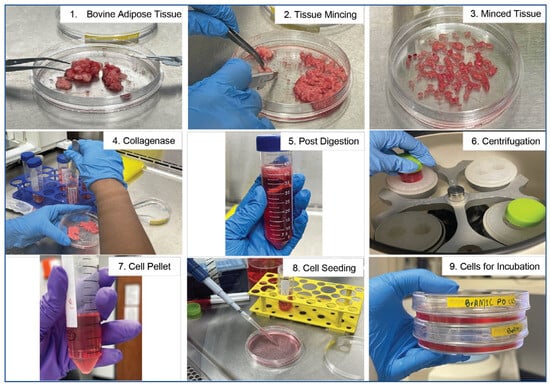
Figure 1
Open AccessArticle
Role of Maternal Antibodies in the Protection of Broiler Chicks against Campylobacter Colonization in the First Weeks of Life
by
Kristof Haems, Diederik Strubbe, Nathalie Van Rysselberghe, Geertrui Rasschaert, An Martel, Frank Pasmans and An Garmyn
Animals 2024, 14(9), 1291; https://doi.org/10.3390/ani14091291 - 25 Apr 2024
Abstract
Thermophilic Campylobacter species are the most common cause of bacterium-mediated diarrheal disease in humans globally. Poultry is considered the most important reservoir of human campylobacteriosis, but so far, no effective countermeasures are in place to prevent the bacterium from colonizing broiler flocks. This
[...] Read more.
Thermophilic Campylobacter species are the most common cause of bacterium-mediated diarrheal disease in humans globally. Poultry is considered the most important reservoir of human campylobacteriosis, but so far, no effective countermeasures are in place to prevent the bacterium from colonizing broiler flocks. This study investigated maternal antibodies’ potential to offer protection against Campylobacter in broiler chicks via a field trial and an immunization trial. In the field trial, breeder flocks with high and low anti-Campylobacter antibody levels in the yolk were selected based on serological screening. Offspring were subsequently monitored for maternal antibodies and Campylobacter prevalence during early life. Although maternal antibodies declined rapidly in the serum of broilers, offspring from flocks with lower anti-Campylobacter antibody levels seemed to be more susceptible to colonization. In the immunization trial, breeders from a seropositive breeder flock were vaccinated with an experimental bacterin or subunit vaccine. Immunization increased antibody levels in the yolk and consequently in the offspring. Elevated maternal antibody levels were significantly associated with reduced Campylobacter susceptibility in broilers at 2 weeks old but not at 1 and 3 weeks old. Overall, the protective effect of maternal immunity should be cautiously considered in the context of Campylobacter control in broilers. Immunization of breeders may enhance resistance but is not a comprehensive solution.
Full article
(This article belongs to the Special Issue The Animal Microbiome in Health and Disease)
►▼
Show Figures
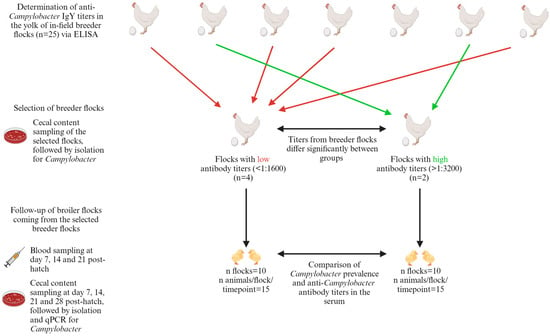
Figure 1
Open AccessArticle
Differential Gene Expression in Porcine Lung Compartments after Experimental Infection with Mycoplasma hyopneumoniae
by
Rubén S. Rosales, David Risco, Obdulio García-Nicolás, Francisco J. Pallarés, Ana S. Ramírez, José B. Poveda, Robin A. J. Nicholas and Francisco J. Salguero
Animals 2024, 14(9), 1290; https://doi.org/10.3390/ani14091290 - 25 Apr 2024
Abstract
Mycoplasma hyopneumoniae (Mhyo) is the causative agent of porcine enzootic pneumonia (EP), as well as one of the main pathogens involved in the porcine respiratory disease complex. The host–pathogen interaction between Mhyo and infected pigs is complex and not completely understood; however, improving
[...] Read more.
Mycoplasma hyopneumoniae (Mhyo) is the causative agent of porcine enzootic pneumonia (EP), as well as one of the main pathogens involved in the porcine respiratory disease complex. The host–pathogen interaction between Mhyo and infected pigs is complex and not completely understood; however, improving the understanding of these intricacies is essential for the development of effective control strategies of EP. In order to improve our knowledge about this interaction, laser-capture microdissection was used to collect bronchi, bronchi-associated lymphoid tissue, and lung parenchyma from animals infected with different strains of Mhyo, and mRNA expression levels of different molecules involved in Mhyo infection (ICAM1, IL-8, IL-10, IL-23, IFN-α, IFN-γ, TGF-β, and TNF-α) were analyzed by qPCR. In addition, the quantification of Mhyo load in the different lung compartments and the scoring of macroscopic and microscopic lung lesions were also performed. Strain-associated differences in virulence were observed, as well as the presence of significant differences in expression levels of cytokines among lung compartments. IL-8 and IL-10 presented the highest upregulation, with limited differences between strains and lung compartments. IFN-α was strongly downregulated in BALT, implying a relevant role for this cytokine in the immunomodulation associated with Mhyo infections. IL-23 was also upregulated in all lung compartments, suggesting the potential involvement of a Th17-mediated immune response in Mhyo infections. Our findings highlight the relevance of Th1 and Th2 immune response in cases of EP, shedding light on the gene expression levels of key cytokines in the lung of pigs at a microscopic level.
Full article
(This article belongs to the Section Pigs)
►▼
Show Figures

Figure 1

Journal Menu
► ▼ Journal Menu-
- Animals Home
- Aims & Scope
- Editorial Board
- Reviewer Board
- Topical Advisory Panel
- Instructions for Authors
- Special Issues
- Topics
- Sections & Collections
- Article Processing Charge
- Indexing & Archiving
- Editor’s Choice Articles
- Most Cited & Viewed
- Journal Statistics
- Journal History
- Journal Awards
- Society Collaborations
- Conferences
- Editorial Office
Journal Browser
► ▼ Journal BrowserHighly Accessed Articles
Latest Books
E-Mail Alert
News
Topics
Topic in
Agriculture, Animals, Dairy, Ruminants, Veterinary Sciences
Practical Methods for Accommodating Behavioral Needs and Improving the Wellbeing of Both Farm Animals
Topic Editors: Temple Grandin, Kurt VogelDeadline: 20 June 2024
Topic in
Agriculture, Agronomy, Animals, Fishes, Poultry
Sustainable Development of Natural Bioactive Compounds/Products in Animal Resource and Agriculture Science: Volume II
Topic Editors: In Ho Kim, Balamuralikrishnan Balasubramanian, Shanmugam SureshkumarDeadline: 30 June 2024
Topic in
Agriculture, Animals, Dietetics, Foods, Insects
Edible Insects as Feed and Food: Opportunities and Challenges
Topic Editors: Rifat Ullah Khan, Shabana NazDeadline: 31 July 2024
Topic in
Agriculture, Animals, Foods, Nutrients, World
The New Era of Food and Agriculture: Sustainable Strategies to Achieve Zero Hunger
Topic Editors: Petru Alexandru Vlaicu, Arabela Elena Untea, Teodora PopovaDeadline: 12 August 2024

Conferences
Special Issues
Special Issue in
Animals
Empirical Animal and Veterinary Medical Ethics
Guest Editors: Svenja Springer, Peter Sandøe, Herwig Grimm, Sonja Hartnack, Barry Kipperman, Sabine SallochDeadline: 30 April 2024
Special Issue in
Animals
Advances in Image-Guided Veterinary Surgery
Guest Editors: Antonello Bufalari, Andrea Corda, Domenico CaivanoDeadline: 15 May 2024
Special Issue in
Animals
Biotechnology and Bioinformatics in Livestock
Guest Editors: Waiyee (Lloyd) Low, Guohua HuaDeadline: 31 May 2024
Special Issue in
Animals
Advances in Wildlife and Exotic Animals Anatomy
Guest Editors: Matilde Lombardero Fernández, María del Mar Yllera FernándezDeadline: 20 June 2024
Topical Collections
Topical Collection in
Animals
Recent Advances in Fish Nutrition: Insights on the Nutritional Implications of Modern Formulations
Collection Editors: Artur Rombenso, Bruno Araújo, Erchao Li
Topical Collection in
Animals
Gut Microbiota and Growth and Health of Monogastric Farm Animals
Collection Editors: Maria Teresa Capucchio, Paolo Bosi
Topical Collection in
Animals
Current Advances in Poultry Research
Collection Editors: John Michael Gonzalez, Casey M. Owens
Topical Collection in
Animals
Nanotechnology in Animal Science
Collection Editors: Antonio Gonzalez-Bulnes, Nesrein M. Hashem




